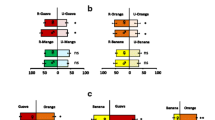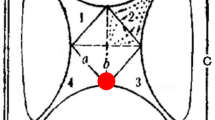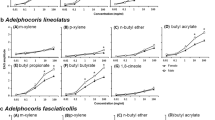Abstract
The fruit fly, Bactrocera dorsalis, is a polyphagous pest that damages a wide variety of fruits in the tropics, including East Africa. In this paper, we aimed to evaluate the attraction of kairomones shared by three hosts of Bactrocera dorsalis to lay the groundwork towards the development of attractants for the management of pests by targeting females. Gas Chromatography-Electroantennographic detection (GC-EAD) and Gas Chromatography-Mass Spectrometry (GC–MS) were carried out to identify compounds that elicit antennal response of B. dorsalis. Recording from the antennae, identified 44 GC-EAD active peaks, most of which were esters. Furthermore, synthetic blends tested were composed of ethyl butanoate, (E)-β-farnesene, trans-β-ocimene and ethyl hexanoate from compounds shared by at least two of the three hosts (Mangifera indica (mango): Sclerocarya birrea (marula), and Terminalia catappa (tropical almond)). Four blends were formulated from shared compounds and evaluated in a multi-choice olfactometer. Our results have shown that the four-compound blend was the most attractive. The results form a springboard for developing host-derived attractants for managing B. dorsalis females, which can form part of an integrated pest management strategy for the pest.



Similar content being viewed by others
Code availability
Not Applicable.
References
Anholt R (2020) Chemosensation and Evolution of Drosophila Host Plant Selection. iScience 23(1):100799. https://doi.org/10.1016/j.isci.2019.100799
Badii KB, Billah MK, Afreh-Nuamah K, Obeng-Ofori D, Nyarko G (2015) Review of the pest status, economic impact and management of fruit-infesting flies (Diptera: Tephritidae) in Africa. Afr J Agric Res. https://doi.org/10.5897/ajar2014.9278
Bengtsson M, Jaastad G, Knudsen G, Kobro S, Backman A-C, Pettersson E, Witzgall P (2006) Plant volatiles mediate attraction to host and non-host plant in apple fruit moth, Argyresthia conjugella. Entomol Exp Appl. https://doi.org/10.1111/j.1570-7458.2006.00359.x
Biasazin TD, Herrera LS, Kimbokota F, Dekker T (2018) Translating olfactomes into attractants: Shared volatiles provide attractive bridges for polyphagy in fruit flies. Ecol Lett. https://doi.org/10.1111/ele.13172
Biasazin TD, Karlsson MF, Hillbur Y, Seyoum E, Dekker T (2014) Identification of host blends that attract the African invasive fruit fly, Bactrocera invadens. J Chem Ecol. https://doi.org/10.1007/s10886-014-0501-6
Ekesi S, Nderitu PW, Chang CL (2007) Adaptation to and Small-Scale Rearing of Invasive Fruit Fly Bactrocera invadens (Diptera: Tephritidae) on Artificial Diet. Ann Entomol Soc Am. https://doi.org/10.1603/0013-8746(2007)100[562:ATASRO]2.0.CO;2
Fitt GP (1984) Oviposition behaviour of two tephritid fruit flies, Dacus tryoni and Dacus jarvisi, as influenced by the presence of larvae in the host fruit. Oecologia. https://doi.org/10.1007/BF00377370
Haniotakis G, Voyadjoglou A (1978) Oviposition regulation in Dacus oleae by various Olive fruit characters. Entomol Exp Appl. https://doi.org/10.1111/j.1570-7458.1978.tb02798.x
Hildebrand JG, Shepherd GM (1997) Mechanisms of olfactory discrimination : Converging Evidence for Common Principles Across Phyla. Annu Rev Neurosci. https://doi.org/10.1146/annurev.neuro.20.1.595
Hull CD, Cribb BW (2001) Olfaction in the Queensland Fruit Fly, Bactrocera tryoni. Identification of olfactory receptor neuron types responding to environmental odors. J Chem Ecol. https://doi.org/10.1023/A:101037461
Jang EB, Light DM, Flath RA, Nagata JT, Mon TR (1989) Electroantennogram Responses of the Mediterranean Fruit Fly. Ceratitis Capitata to Identified Volatile Constituents from Calling Males, Entomol Exp Appl. https://doi.org/10.1111/j.1570-7458.1989.tb02307.x
Jayanthi PDK, Kempraj V, Aurade RM, Venkataramanappa RK, Nandagopal B, Verghese A, Bruce T (2014) Oviposition Site-Selection by Bactrocera dorsalis is mediated through an Innate Recognition Template Tuned to γ-Octalactone. PLoS ONE. https://doi.org/10.1371/journal.pone.0085764
Jayanthi PDK, Woodcock CM, Caulfield J, Birkett MA, Bruce TJA (2012) Isolation and Identification of Host Cues from Mango, Mangifera indica, That Attract Gravid Female Oriental Fruit fly, Bactrocera dorsalis. J Chem Ecol. https://doi.org/10.1007/s10886-012-0093-y
Joseph RM, Carlson JR (2015) Drosophila Chemoreceptors: A Molecular Interface between the Chemical World and the Brain. Trends in Genetics: TIG 31(12):683–695. https://doi.org/10.1016/j.tig.2015.09.005
Katsoyannos BI, Pittara IS (1983) Effect of size of artificial oviposition substrates and presence of natural host fruits on the selection of oviposition site by Dacus oleae. Entomol Exp Appl. https://doi.org/10.1111/j.1570-7458.1983.tb03342.x
Kimbokota F, Njagi PGN, Torto B, Ekesi S, Hassanali A (2013) Responses of Bactrocera invadens (Diptera: Tephritidae) to Volatile Emissions of Fruits of Three Host Plants. J Biol Agri Healthcare 3(6):53–60
Kimbokota F, Torto B (2013) Candidate Attractants for Bactrocera invadens (Diptera: Tephritidae) male flies from Gynandropsis gynandra (Capparidaceae). J Nat Sci Res 3:35–44
Koyama J, Teruya T, Tanaka K (1984) Eradication of the Oriental fruit fly (Diptera: T Aphididae) from the Okinawa Islands by a male annihilation method. J Econ Entomol. https://doi.org/10.1093/jee/77.2.468
Light DM, Jang EB, Dickens JC (1988) Electroantennogram responses of the Mediterranean fruit fly, Ceratitis capitata, to a spectrum of plant volatiles. J Chem Ecol. https://doi.org/10.1007/BF01022539
Light DM, Jang EB, Flath RA (1992) Electroantennogram responses of the Mediterranean fruit fly, Ceratitis capitata, to the volatile constituents of nectarines. Entomol Exp Appl. https://doi.org/10.1111/j.1570-7458.1992.tb02415.x
Lux SA, Copeland RS, White IM, Manrakhan A, Billah MK (2003) A new invasive fruit fly from the Bactrocera dorsalis (Hendel) group detected in East Africa. Insect Sci Appl. https://doi.org/10.1017/S174275840001242X
Manoukis NC, Vargas RI, Carvalho L, Fezza T, Wilson S, Collier T et al (2019) A field test on the effectiveness of male annihilation technique against Bactrocera dorsalis (Diptera: Tephritidae) at varying application densities. PLoS One. https://doi.org/10.1371/journal.pone.0213337
Mwatawala MW, White IM, Maerere AP, Senkondo FJ, De Meyer MA (2004) New invasive Bactrocera Species (Diptera: Tephritidae) in Tanzania. African Entomology 12:154–156
Nguyen VL, Meats A, Beattie GAC, Spooner-Hart R, Liu ZM, Jiang L (2007) Behavioural responses of female Queensland fruit fly, Bactrocera tryoni, to mineral oil deposits. Entomol Exp Appl. https://doi.org/10.1111/j.1570-7458.2006.00504.x
Nojima S, Linn C, Morris B, Zhang A, Roelofs W (2003a) Identification of host fruit volatiles from hawthorn (Crataegus spp.) attractive to hawthorn-origin Rhagoletis pomonella flies. J Chem Ecol. https://doi.org/10.1023/A:1022677827233
Nojima S, Linn C, Roelofs W (2003b) Identification of host fruit volatiles from flowering dogwood (Cornusflorida) attractive to dogwood-origin Rhagoletis pomonella flies. J Chem Ecol. https://doi.org/10.1023/A:1026282632715
Oksanen J, Blanchet FG, Friendly M, Kindt R, Legendre P, McGlinn D, Minchin PR, O’Hara RB, Simpson GL, Solymos P, Stevens HH, Szoecs E, Wagner H (2018) Vegan R package, 2.0–10. Commun Ecol Package. Available at http://CRAN.R-project.org/package=vegan
Pittara IS, Katsoyannos BI (1992) Effect of shape, size and color on selection of oviposition sites by Chaetorellia australis. Entomol Exp Appl. https://doi.org/10.1111/j.1570-7458.1992.tb01565.x
Robacker DC (2012) Effects of shape and size of colored traps on attractiveness to irradiated, laboratory-strain Mexican fruit flies (Diptera: Tephritidae). Fla Entomol. https://doi.org/10.2307/3495625
Shelly TE (2000) Fecundity of Female Oriental Fruit Flies (Diptera: Tephritidae): Effects of Methyl Eugenol-Fed and Multiple Mates. Ann Entomol Soc Am. https://doi.org/10.1603/0013-8746(2000)093[0559:fofoff]2.0.co;2
Shelly TE, Villalobos EM (1995) Cue lure and the mating behavior of male melon flies (Diptera: Tephritidae). Fla Entomol. https://doi.org/10.2307/3495532
Siderhurst MS, Jang EB (2006) Female-Biased Attraction of Oriental Fruit Fly, Bactrocera dorsalis (Hendel), to a Blend of Host Fruit Volatiles From Terminalia catappa L. J Chem Ecol. https://doi.org/10.1007/s10886-006-9160-6
Steiner LF, Mitchell WC, Harris EJ, Kozuma TT, Fujimoto MS (1965) Oriental fruit fly eradication by male annihilation. J Econ Entomol. https://doi.org/10.1093/jee/58.5.961
Vargas RI, Leblanc L, Pinero JC, Hoffman KM (2014) Male annihilation, past, present, and future. In: Shelly T, Epsky N, Jang EB, Reyes-Flores J, Vargas R (eds) Trapping and the detection, control, and regulation of tephritid fruit flies. Springer, Netherlands, pp 493–511
Vargas RI, Piñero JC, Mau RFL, Jang EB, Klungness LM, Mclnnis DO, Harris EB, McQuate GT, Bautista RC, Wong L (2010) Area-wide suppression of the Mediterranean fruit fly, Ceratitis capitata and the Oriental fruit fly, Bactrocera dorsalis, in Kamuela, Hawaii. J Insect Sci. https://doi.org/10.1673/031.010.13501
Acknowledgements
The research was financed by the Netherland Government in Cooperation with International Organisations (SII) through the International Centre of Insects Physiology and Ecology (icipe) under African Regional Postgraduate Program in Insect Sciences (ARPPIS) and Schlumberger Foundation under the Faculty for the Future Programme. Swedish University of Agricultural Sciences, Department of Plant Protection Biology, Alnarp, is acknowledged for providing facilities to carry out part of this work. Drs. Mbwiga S. Aloni and Sebastian Larsson Herera are highly acknowledged for assisting in data analysis.
Funding
The research was financed by the Netherlands Government in Cooperation with International Organisations (SII) through the International Centre of Insects Physiology and Ecology (icipe) under African Regional Postgraduate Program in Insect Sciences (ARPPIS). The authors also acknowledge the funding from Schlumberger Foundation under the Faculty for the Future Programme that funded part of the work carried out at the Swedish University of Agricultural Sciences, Department of Plant Protection Biology, Alnarp.
Author information
Authors and Affiliations
Corresponding author
Ethics declarations
Ethics approval
Not Applicable.
Conflict of interest
All authors declare that there is no conflict of interest.
Additional information
Publisher's Note
Springer Nature remains neutral with regard to jurisdictional claims in published maps and institutional affiliations.
Supplementary Information
Below is the link to the electronic supplementary material.
Rights and permissions
Springer Nature or its licensor (e.g. a society or other partner) holds exclusive rights to this article under a publishing agreement with the author(s) or other rightsholder(s); author self-archiving of the accepted manuscript version of this article is solely governed by the terms of such publishing agreement and applicable law.
About this article
Cite this article
Kimbokota, F., Hassanali, A. & Njagi, P.G.N. Potential attractants from three host plants of Bactrocera dorsalis (Hendel) (Diptera: Tephritidae). Int J Trop Insect Sci 43, 107–114 (2023). https://doi.org/10.1007/s42690-022-00914-3
Received:
Accepted:
Published:
Issue Date:
DOI: https://doi.org/10.1007/s42690-022-00914-3




